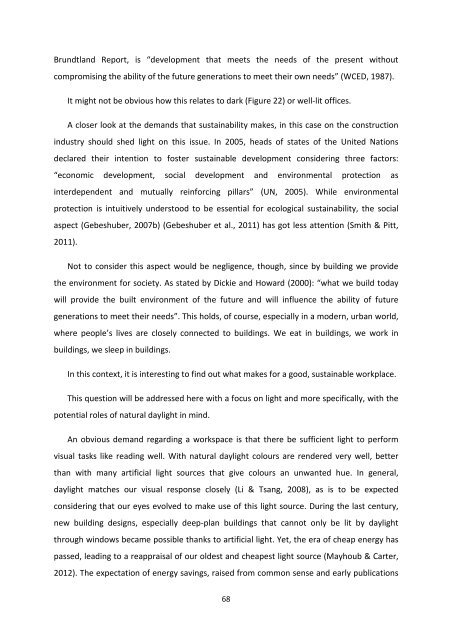MASTER THESIS Biomimetic potential of sponge ... - IAP/TU Wien
MASTER THESIS Biomimetic potential of sponge ... - IAP/TU Wien
MASTER THESIS Biomimetic potential of sponge ... - IAP/TU Wien
You also want an ePaper? Increase the reach of your titles
YUMPU automatically turns print PDFs into web optimized ePapers that Google loves.
Brundtland Report, is “development that meets the needs <strong>of</strong> the present without<br />
compromising the ability <strong>of</strong> the future generations to meet their own needs” (WCED, 1987).<br />
It might not be obvious how this relates to dark (Figure 22) or well-lit <strong>of</strong>fices.<br />
A closer look at the demands that sustainability makes, in this case on the construction<br />
industry should shed light on this issue. In 2005, heads <strong>of</strong> states <strong>of</strong> the United Nations<br />
declared their intention to foster sustainable development considering three factors:<br />
“economic development, social development and environmental protection as<br />
interdependent and mutually reinforcing pillars” (UN, 2005). While environmental<br />
protection is intuitively understood to be essential for ecological sustainability, the social<br />
aspect (Gebeshuber, 2007b) (Gebeshuber et al., 2011) has got less attention (Smith & Pitt,<br />
2011).<br />
Not to consider this aspect would be negligence, though, since by building we provide<br />
the environment for society. As stated by Dickie and Howard (2000): “what we build today<br />
will provide the built environment <strong>of</strong> the future and will influence the ability <strong>of</strong> future<br />
generations to meet their needs”. This holds, <strong>of</strong> course, especially in a modern, urban world,<br />
where people’s lives are closely connected to buildings. We eat in buildings, we work in<br />
buildings, we sleep in buildings.<br />
In this context, it is interesting to find out what makes for a good, sustainable workplace.<br />
This question will be addressed here with a focus on light and more specifically, with the<br />
<strong>potential</strong> roles <strong>of</strong> natural daylight in mind.<br />
An obvious demand regarding a workspace is that there be sufficient light to perform<br />
visual tasks like reading well. With natural daylight colours are rendered very well, better<br />
than with many artificial light sources that give colours an unwanted hue. In general,<br />
daylight matches our visual response closely (Li & Tsang, 2008), as is to be expected<br />
considering that our eyes evolved to make use <strong>of</strong> this light source. During the last century,<br />
new building designs, especially deep-plan buildings that cannot only be lit by daylight<br />
through windows became possible thanks to artificial light. Yet, the era <strong>of</strong> cheap energy has<br />
passed, leading to a reappraisal <strong>of</strong> our oldest and cheapest light source (Mayhoub & Carter,<br />
2012). The expectation <strong>of</strong> energy savings, raised from common sense and early publications<br />
68

















